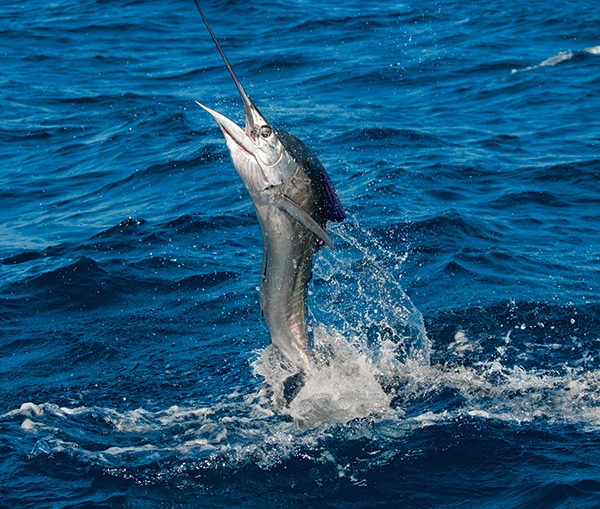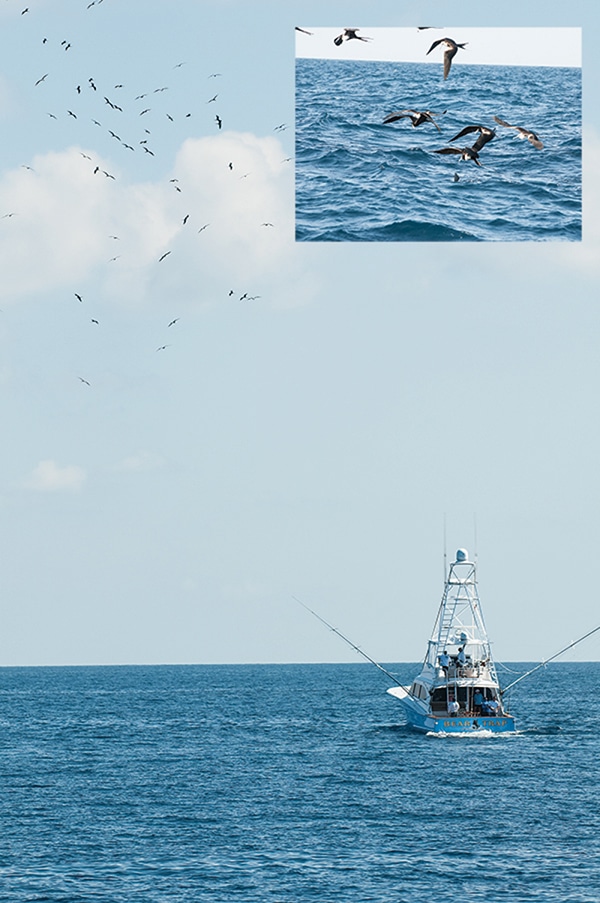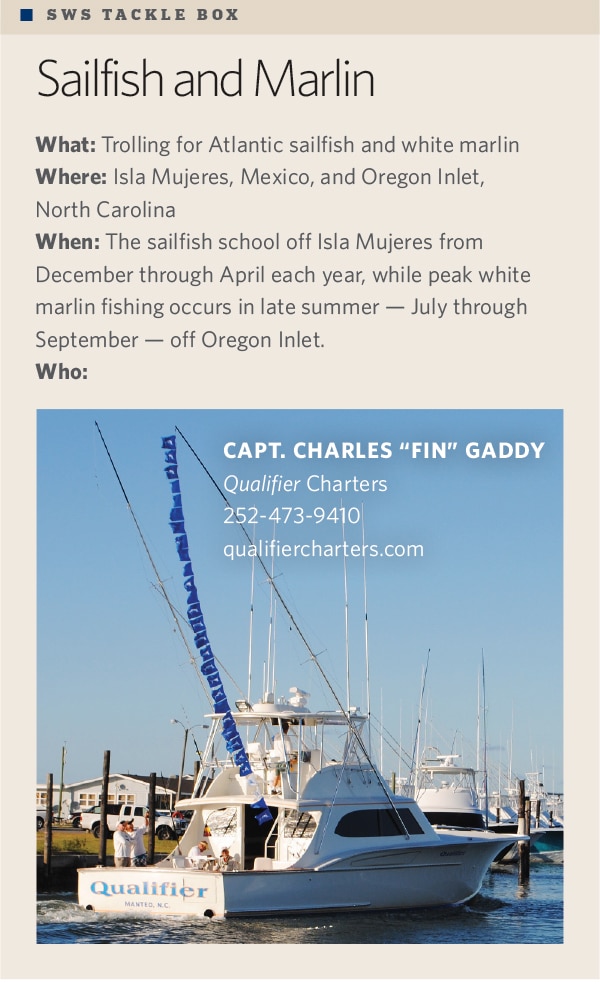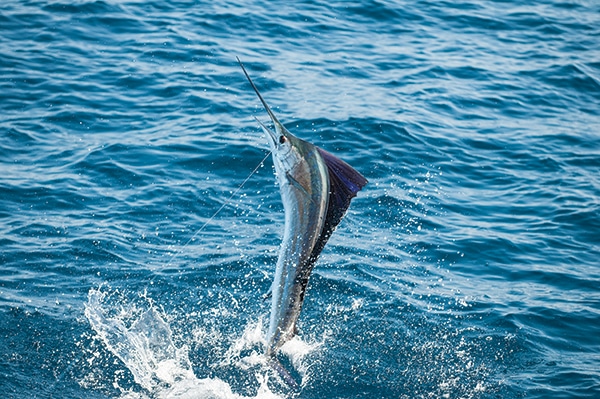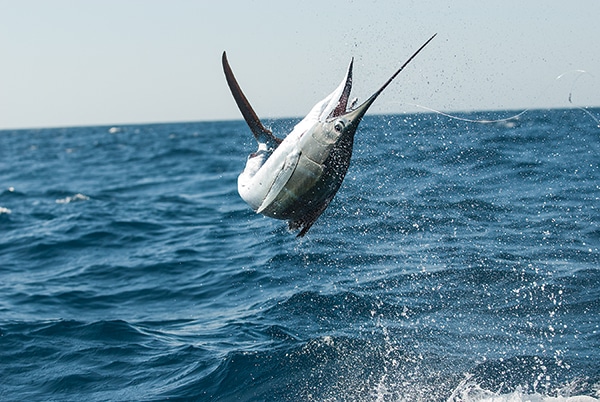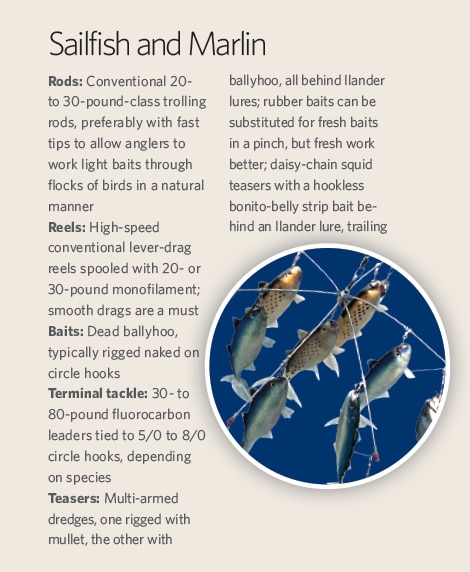As we approached the large flock of frigate birds hovering just above the surface, I began to make out sailfish dorsals cutting through the water beneath them. Frantic baitfish sought escape as death loomed above and below them, often to no avail. The frigates and sailfish had them trapped.
Capt. Charles “Fin” Gaddy steered Qualifier, his 57-foot Paul Mann, into a wide circle to pull our skipping ballyhoo directly into the chaos. As the long rigger bait moved directly beneath the diving birds, mate Chris Kubik said, “Now,” and my wife, Poppy, threw her reel into free-spool, dumping the bait directly into the school of fish below.The bite came instantly; line flew off the reel, and after a few seconds of drop-back, she engaged the drag, and the circle hook found the corner of the mouth of the sail that had eaten it. Fish on! The sailfish put on the usual acrobatic display before Poppy brought it boat-side, where we placed a Billfish Foundation tag in its shoulder, cut the leader and sent the fish on its way, somewhat tired but in overall good shape.
Hot Isla Bite
Gaddy had invited us to fish with him at Isla Mujeres, off Mexico’s Yucatan Peninsula, one of the world’s best places to catch Atlantic sailfish. He has fished the winter season off Isla aboard this and previous versions of Qualifier for many seasons, and he and Kubik have become experts at raising and catching sailfish and white marlin, both in Mexico and in their home waters off North Carolina’s Oregon Inlet. I jumped at the chance to fish with these two pros and learn some of their techniques.
“The two most important pieces of equipment I use are binoculars and a great bottom machine,” Gaddy says. “Finding the fish is the most important thing, and with fuel at a premium, binoculars are worth their weight in gold. Over the years I have used imagestabilized binoculars from Canon and Nikon, but my most recent and favorite is the Mariner by Fraser Volpe. I can’t count how many times I have benefited from the use of these, both in Isla finding sails and Oregon Inlet finding cutting white marlin. Not to mention locating flotsam for dolphin.”
Where’s the Bait?
Finding and staying on baitballs is also key. “I use the Furuno FCV 1150 sounder with a wide-beam Airmar 270 transducer,” Gaddy says. “Using the 50 kHz frequency allows me to mark individual whites, sails and blues, which in turn helps me to focus on an area that’s holding fish that might not get another circle had I not seen them. The wide beam allows my machine to cover more water in a shallower setting versus a narrower cone.”
Gaddy also has specific tackle preferences for working around diving birds. “When working birds over a baitball, I prefer a reel with a fast retrieve,” he explains. “This allows the angler to skip the bait into the ball, and makes it easier to keep the line tight when circling a hooked fish.” When turning the boat, the baits on the inside of the circle lose velocity, while the outside baits accelerate; a high-speed reel allows the angler to compensate for this and keep the bait acting naturally.
Give Them a Taste
In the cockpit, Kubik has a deadly system for attracting the attention of passing billfish. “When we light-tackle fish for whites and sails, we usually fish two squid-chain teasers with an Ilander lure and a bonito strip behind it,” Kubik says. “A few years ago, I tried fishing the strip instead of a ballyhoo behind my chains, and I have never gone back. I like the strip because the fish can’t pull it off like they do a ballyhoo. They still get the taste, but when they bite it and come away with nothing, it really gets them jacked up.”
Kubik and Gaddy fish four ballyhoo rigged on circle hooks: Two ride just behind the teasers, and two more skip on the long outriggers. Two more pitch baits wait in the cockpit as backup. “When we get a fish on the teaser, I pop my flat line out and, depending on where my teasers are, I either crank it up or drop it back a little in an effort to get it even with the back of the teaser,” Kubik says. “If everything goes according to plan, Fin pulls the teaser away from the fish, and the fish homes in on my bait. Many times the fish does not acknowledge my bait, and continues to chase the teaser closer and closer to the boat. I will crank up my bait to try to get the fish to switch, but I am careful not to reel up too close to the boat. Bites that occur just off the transom tend to be too aggressive, and your percentage goes down.
“If the fish follows up so close that he is next to me, I will leave my bait back there about 30 feet and hold it out in the clean water,” Kubik continues. “When Fin pulls the teaser out of the water completely from the bridge, the fish usually does a 180, and the first thing he should see is my bait.” Kubik adds that backup is important.
“This style of fishing is all about backup; you need to have a backup man,” he says. “If the teaser fish never sees my bait, or even if I miss him, you need to watch the long riggers because that fish will fade back to another bait.”
Up and Out
Rod-handling technique**** at the crucial moment helps too. “When trying for a teaser fish, hold the rod up and out,” Kubik says. “When the fish bites your bait, point your rod at the fish and free-spool. That motion is your shock absorber. You don’t want the fish to feel you.” If the fish feels any tension on the line, it will drop the bait, and when you come tight, you’ll find nothing on the end of your line. It sounds easy, but it’s a technique refined only through lots of practice.
Dredges play a key role as well. “We typically fish two dredges: one rigged with ballyhoo and one with mullet,” Kubik says. “When a fish has its head buried in the dredge, I try to get my flat line about 10 feet ahead of the dredge, and sink my bait and crank up the dredge at the same time. Sometimes I have to do this a few times to get the fish to come out of the dredge.”
Many crews also employ a technique called “prospecting” when fishing dredges. This involves repeatedly free-spooling a hook bait over the top of the dredge so it sinks naturally in the wash as the boat moves away. The idea is to simulate a wounded baitfish being separated from the school — the fake school simulated by the dredge in this case — and attracting the attention of a billfish that might be following the dredge, unseen from the boat. Prospecting can be a very effective method for picking off stragglers.
Common Courtesy
Fishing around diving birds is a specialized form of sight-fishing, and Gaddy correctly points out some basic rules of the road for success. “Last year it was a race for the birds,” he says. “One day I had numerous boats cut inside my circle when I had yet to catch a fish. People pushing you off birds took away from the joy of being in Mexico.”
The same can be true in the States however. “This year here at home, we’ve had boats moving in while we were circling the birds as the cutters were feeding, and start casting from the bow,” Gaddy says. “We go to have a great time, and cutting into someone’s birds without an invitation or without asking is just rude. When we work together, everyone benefits.”
Sounds like common sense, and by employing a little of that along with the tactics developed by the Qualifier crew, you too can become adept at raising a sailfish or white marlin behind your boat. Once you figure it out, you’ll be hooked — just like the rest of us who find this style of fishing so fascinating and exciting
